Return on Investment or ROI is the percentage of your net returns or profits that you expect to get back on your investment, that is app development in this case. It is a driving factor that decides whether an investment is capable of generating good returns and a bright future for the investor. Various mobile apps are built by the companies to generate more ROI. The apps make sure that the products reach maximum customers, and hence generate better sales. Therefore it becomes equally important to know whether the time you spent on app development is worth enough or not. All the functions in the app such as coding, UI/UX designing, etc must be done keeping the present customer demands in check. The user acquisition, customer retention rate, and viewership percentage must be calculated to check the ROI from the apps. We, at JPLoft , have 14 years of experience in various mobile and web applications. We have a proven track record of generating maximum ROI for different businesses that helps them generate more investment and profits.
Tips to Forecast the ROI in App Development
If you are a developer and looking to predict the ROI of your app, below are a few details on how to do the same efficiently. It would help if you kept them in mind while planning your app development strategy.
Get your Application Goals in one Place
The most important thing that you need to sort out is what you demand from your application. The entire process, starting from developing the prototype and ending with the application launch must be fully-proof. The target audience must be decided carefully along and the content marketing needs to be done effectively so that the idea behind the app reaches the target audience. This process holds a lot of importance in brand building as well.
Cost of App Development
The total budget for building an app must be kept in check at every stage of its development. The designing team must be informed about the expenses incurred at every stage so that they do not exceed the allotted budget. The expenses could be broken down into different stages of app development into the categories such as:
- Prototyping the app
- Implementation
- Software programming
- User Interface
- Aid and Integration
Selecting the Right KPIs
A Key Performance Indicator , also known as KPI, is probably the best feature to judge the ROI of your app. The KPIs are managed by setting targets and working on the leading indicators. The KPIs could vary with the variety of applications and their usage. Some of the common factors that help in KPI measurement include are
- The total number of app downloads
- Customer stay of more than 3 months
- Day-by-day usage sessions
- The regular income per client
- Degree of Compatibility
Deciding Costs concerning KPIs
Once the KPIs are set for your app, the next approach is to check if the KPIs could recover your investments. Before calculating the KPI, it becomes important to predict the app's lifespan first. The lifespan of the app decides whether the app requires a higher or lower investment.
Also Read: How to make money through Mobile App?
The budget directly depends on the life span of the app and the features that need to be added to it. Experts claim that the ROI of an app becomes high, only when the budget for building the app is judged and defined well.
Conclusion
ROI is a particular area of concern for many businesses that run their application. It is a key metric that determines the effectiveness of an application. Generally, the ROI is calculated using the formula: ROI= (Net Return on Investment/ Cost of Investment)* 100. So, if you are spending USD 2000 per month on running an advertising campaign and generate USD 4000 in return, your ROI is obtained by dividing 4000 by 2000, which equals 2. This means for every dollar that is spent on the campaign, your business earns 2 dollars. Thus, ROI would continue to be a leading factor in determining the outcome of a business and companies would invest even more in finding out the suitable ROI for their businesses.








